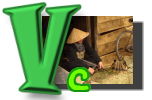WATCHES
Watches below described from right to left
 |
A)
US
Army genuine
military issue, metal case dated 1968
B)
US
Army genuine
military issue, plastic case dated 1966
C)
Timex current copy
D) Genuine 60's civilian watch
E) Modern Seiko (but 60/70's style)
Type of watch was often worn by officers and NCO
|
|
Please
do not wear digital watches. |
DESCRIPTION
AND DATA
Jungle Uniform, Jacket/Trousers

Three main type of jungle jackets were used
during the Vietnam War, the main difference being as follows.
1st pattern,
poplin material, with exposed buttons, jacket with shoulder
straps, side tabs and neck gas flap, trousers with button fly, leg
ties and button waist tabs
2nd pattern,
jacket and trousers identical to above but with concealed
buttons
3rd pattern, type A
in poplin, concealed buttons, no shoulder straps, no side tabs, no
gas flap, trousers button or zip fly, no leg ties and buckle waist
tabs.
3rd pattern, type B
identical but made of rip stop material, trousers zip fly, no leg
ties and buckle waist tab
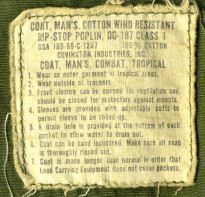
|
PLEASE
NO REPRO.
The real stuff is cheap enough.
ERDL cammo can also been worn for specific theme displays,
check with your group leader.
Please fill up your pocket when
representing field troops. |
UNDER GARMENTS
Military underwear is
not essential, although most members do wear them. T-shirts should
be Olive Drab. (See bellows)
Old white t-shirts are OK for early stuff (up to 1965) (don't
forget you would have made a nice target with them!)
HATS
Cap, field,
hot weather, OG-106, generally not liked by the troops.
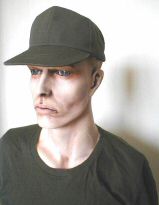
This Photo also shows the correct issue T-shirt. This one is late
70's but is identical to the 60's one.
|
Notes
Watch out for post the war cap with only four vent
holes instead of six. (These are not acceptable)
|
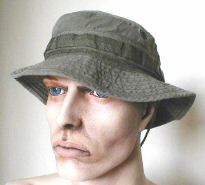
Hat,
jungle with insect net, (the much loved boonie hat), standard
issue from summer 1967 onwards.
|
Post War with coarse nylon foliage band
are not acceptable.
No repro, Israeli or British boonie hats. |
BOOTS
Three patterns of jungle boots were produced during the
Vietnam War, with the 3rd pattern (see
photos) being distributed from 1967 onwards. The first jungle boot
arrived in 1962/63 and the 2nd pattern in late 1965.
Prior to early 1966, the most common boot in Vietnam was the black
leather combat boot. The black leather combat boot remained in use
throughout the war for flying personnel for safety reasons.
Black leather and green
canvas US issue jungle boots for all members (preferably 60's but
80's OK),

The one on left is a 1985 US Issue, the one on the right with the seam on the heel is dated 1968 and is the 3rd pattern
with the panama sole
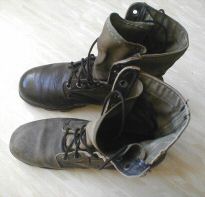
The
top boot is polished and as worn by Base assigned personnel.
The lower one is grey and dry as worn by field troops. Boots would
nearly turn kind of a greyish/tan colour if not polished
regularly.
|
Notes
All 60ís
jungle boot have vertical seam running up the heel. Also the
60ís all leather boot should not have a relief cut in the
lacing area at ankle height.
|
INSIGNIA
Most
troops in the field tended not to wear insignia on their uniforms.
However if you do want to wear some, they must be the proper U.S.
Army issue twill or Ďlocalí Vietnamese-made subdued types.
Colour
insignia were only worn early in the war, except for 101st, 82nd
Airborne, and the 1st Inf Div which retained their colour insignia
throughout the war. The
subdued version was authorised for wear from June 1966, with most
units achieving the changeover by the end of 1967.

Full colour, merrow type subdued, Vietnam
made subdued
Pin on
rank insignia was authorised in the summer of 1967 and a mixture
of pin on and subdued sleeve rank insignia will be seen until the
end of the war. The
merrow edge type patches and ranks appeared in Vietnam circa
1970/72 in subdued version only. The full colour version was not
distributed in Vietnam. Stay away from those as they do not
reflect the type of insignia worn during the war.
NO MERROW EDGE
To help you out, a
detailed photo of different types of manufacture is shown.
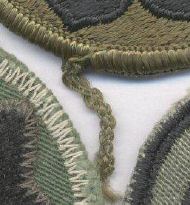
Top is
the merrow edge recognised by its thread tail.
Right is the US factory twill type with a cut edge. Left is
a Nam-made one, which is of similar construction to the twill but
with various backings and was roughly made by tailors.
|
Prior to April 1965, the white name tag
and the black on gold US ARMY tapes were worn. During the
next two years, they were gradually replaced by the subdued
version.
|
Vietnamese-made
name tapes and
US
name tapes
They are the correct one and the most representative of Vietnam
war.


US-made
embroidered or printed name and US tapes appeared late in the war
and are best avoided


US made nylon tapes,
appeared in
Vietnam
circa,1970/72 and are
best avoided.


Best avoided!
|
Tapes position:
Prior to Feb 1968, tapes were worn either at an angle or
parallel to the floor, Feb 68 to Sep 69 parallel to the
ground and from Sept 69 at an angle for better visibility.
NO
NYLON TAPES OR GERMANS/BRITISH NAME TAPES
|
INSIGNIA WEAR:
Remember we have not earned the right to wear these uniforms or
insignia,
so go steady as we don't want to offend Veterans.
When worn they must relate to the age of the wearer
and rank.
Equipment, Helmet
M1 helmet with
correct liner and green canvas straps
(not nylon, no Bundeswehr helmet/liner). This must be covered with
wine tree/frog and leaf helmet cover, with virtually no graffiti.
You should have the narrow green helmet band with only few
items sensibly attached to it.
(Acceptable, bug juice, C rat toilet paper or matches,
cigarettes).
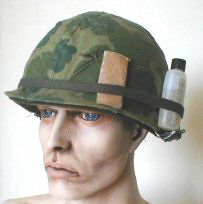
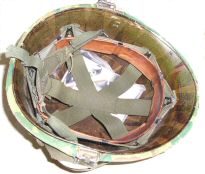
Here
are some items you can carry in your helmet band,
TOP: cigarette pack, toilet paper and matches (all out of 60's
ration packs)

BOTTOM:,
two different bottles of bug juice,
The matches on the bottom right are from a modern MRE and are not
acceptable.
|
Basically
donít over do it! |
You need to use the M56 load bearing
equipment. It comprises of canvas pistol belt, a set of suspenders
(available in small, medium, large), two canvas ammo pouches, two
genuine plastic 60/70 US water bottle with covers (no British
French or German) and 1st aid pouch. All of these items are also
available in the later 1967 pattern which was only issued late in
the war.
The M56 is more typical of the Vietnam War and you will be able to
represent an early or late period with them. Also required is an
M16 bayonet. We would also advise people to obtain one or two 7
pocket ammo bandoleer (filled with mags or blocks of wood).

Above
the most common configurations, with a space left for your
rucksack to rest in the centre rear.
The "butt pack" is an optional
item and not required as this was only used early in
the war and generally disliked by the troops.

M56 suspenders with 1st Aid pouch and snap
link, also seen is the M16 bayonet.

M
56 pistol belt with water
bottle and early cover. The later type will have nylon trim, still
OK for Vietnam.
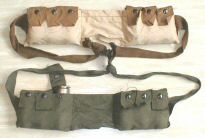
M79 grenadier ammo bandoleers

Top:
M56 ammo pouch with 1st Aid pouch attached to it.
Bottom:
The 7 pouch bandoleer,
(note strap must be made of cotton for
Vietnam
era, not nylon
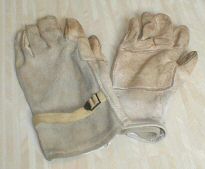
Work gloves dated 1990 but
identical to the 60's one.
These were often carried by troops in the field.


The Lightweight rucksack is
the one you should go for. Shown here is a lightweight ruck with
rubberised poncho, cammo poncho liner and a machete tucked into
it. Machetes were usually attached to rucksacks as they were
cumbersome to carry.


A machete (60's type) and entrenching tool will add a nice
touch to your equipment. Be careful,
modern US Army machetes are different from the 60ís ones and are
unacceptable (check your date on the scabbard and machete). The
modern Alice ruck with square frame is not acceptable.

M56 entrenching tool and cover with bayonet attached to it.

Snap
link. This is the correct type, this one is dated 70 on the
reverse, (80's one are identical and OK).
Wear the right gear for whatever mission you are
supposed to represent. Don't stand on base guard duty with a
machete, rucksack or butt pack! When you wear a ruck or ammo
pouches, make sure they are full.
Again do your research and check what your unit was wearing
during the specific period you are depicting.
FEMALE UNIFORM
This is a very brief overview on female uniform.

Hot weather field uniform
was made of olive green cotton poplin army shade 107 and later of
ripstop material. It consisted of a long sleeve single breasted
shirt with protective gaz flap, two breast patch pockets, buttoned
shoulder loops, and a pencil pocket on the left shoulder.


The
trousers or slacks were tapered with two front bellow pockets,
waistbands closed by two-buttons on each side.


The shirt and trousers could be worn bloused or unbloused.
The shirt sleeves were generally worn rolled up.
The
uniform was completed with jungle boots or black leather combat
boots and boonie hat or field hat.

All
nurses were officers, the majority being first or second
lieutenants. They belonged to the 44th Medical Brigade, USARV or
the 1st Logistical Command. Nurses would wear either
pin on or cloth insignia on their collars and sometimes a unit
pocket patch was hung from their right pocket.
Small items such as round nose scissors and pens can be
added to the pockets as well as watches.
It must also be noted that many WAC (Woman Army Corps) worked for
USARV and were employed in administrative positions where all
ranks were found. Note
female shoulder ranks insignia differ in size from men ones. For
more details on insignia see the insignia section.

44th
Medical Brigade
Subdued

1st
Logistical Command, Colour

US Army
Vietnam
Subdued
Female appearance tended to follow civilian fashion despite
military directives. Hair
regulation was to be well groomed and the lenght not to extend
below the bottom edge of the collar.
Make up and nail varnish had to be discreet, hair ties had
to be the same colour as your hair and jewellery was not allowed.
VEHICLES
Take
your number plate off (magnetic ones are very convenient)
Take off or hide your tax disc.
Have your vehicle in relatively good painted condition. No red
primer was available to field troops in Nam
Hide or remove flashers/non regulation lights for the bigger
shows.
No modern stuff on vehicles, like water /petrol cans.
For vehicle drivers, have a correctly badge shirt matching your
vehicle unit












































